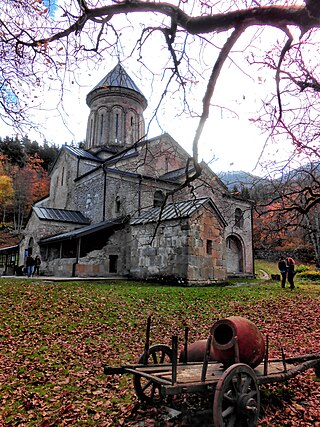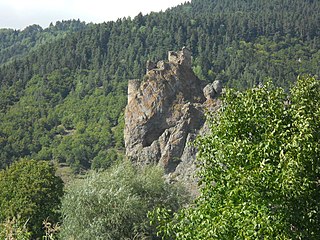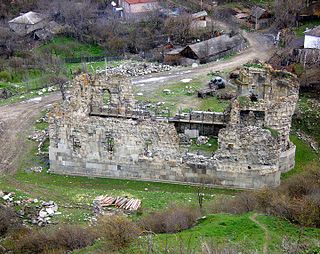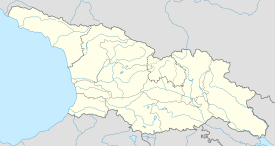
Joseph Volokolamsk Monastery is a monastery for men, located 17 km northeast of Volokolamsk, Moscow Oblast. In the 15th and 16th century, it rivaled the Trinity as the most authoritative and wealthy monastery in Russia. It was frequently referred to as lavra, although there was no official corroboration of that status.

Kintsvisi Monastery is a Georgian Orthodox monastery in the Shida Kartli region, eastern Georgia, 10 kilometers from the town Kareli, on a forested slope of a high mountain of the Dzama valley. Its main church is an exceptional example of a brick church from the Georgian Golden Age period. The monumental mural is one of the largest among the Medieval Georgian artistic ensembles.

The architecture of Georgia refers to the styles of architecture found in Georgia. The country is exceptionally rich in architectural monuments. Characteristic features of the Georgian architecture are monumentality, clear composition, strict proportions, moderate use of decorations, and above all these the harmonic interaction with nature.

Pitareti Monastery is a medieval Orthodox Christian monastery in Georgia, approximately 26 km southwest of the town of Tetritsqaro, Kvemo Kartli, southwest of the nation's capital Tbilisi.

The House of Jaqeli was a Georgian princely (mtavari) family and a ruling dynasty of the Principality of Samtskhe, an offshoot of the House of Chorchaneli.
Sargis I Jaqeli was a Georgian ruling prince (mtavari) of the House of Jaqeli who became the first sovereign Prince of Samtskhe in 1268.

The Chulevi monastery of St. George is a 14th-century Georgian Orthodox monastic church located in Georgia's southwest region of Samtskhe-Javakheti.

Samtavro Monastery is a Georgian Orthodox Christian monastery complex that combines Samtavro Transfiguration Church and Nunnery of St. Nino in Mtskheta, Georgia. Built presumably in the 4th century by the King Mirian III, and reconstructed in the 11th century by the King George I and Catholicos-Patriarch Melchizedek I, Samtavro is an important Early and High Medieval historical and architectural monument, and was inscribed on the UNESCO World Heritage List in 1994 along other historical monuments in Mtskheta. Samtavro church is cross-in-square temple, with arches and other decorations typical for the 11th century Georgian architecture. The graves of Mirian III and the famous Georgian Saint monk Gabriel are located in the yard of Samtavro Church.

Abastumani is a small town (daba) and climatic spa in Adigeni Municipality, Samtskhe-Javakheti, Georgia. It is located on the southern slopes of the Meskheti Range, in the small river valley of Otskhe, 25 km northeast of Adigeni and 28 km west of Akhaltsikhe. As of the 2014 census, it had a population of 937. The Georgian National Astrophysical Observatory is located at Abastumani.

Sanahin Monastery is an Armenian monastery founded in the 10th century in Sanahin in the Lori Province of Armenia.

Sapara Monastery is a Georgian Orthodox monastery in the Akhaltsikhe District of Samtskhe-Javakheti region, Georgia.

The Samtskhe-Saatabago or Samtskhe Atabegate, also called the Principality of Samtskhe, was a Georgian feudal principality in Zemo Kartli, ruled by an atabeg (tutor) of Georgia for nearly three and a half centuries, between 1268 and 1625. Its territory consisted of the modern-day Samtskhe-Javakheti region and the historical region of Tao-Klarjeti.

The Largvisi Monastery is a medieval Georgian Orthodox monastic foundation at the village of Largvisi in the Ksani river valley in the Akhalgori Municipality, what is now the disputed territory of South Ossetia. The monastery is documented from the early 14th century. The extant church, a domed cross-in-square design, dates to 1759. It was a familial abbey of the Kvenipneveli dynasty, Dukes of Ksani and one of the leading noble families of the Kingdom of Kartli.
Ivane-Qvarqvare Jaqeli-Tsikhisjvareli was a Georgian nobleman of the Jaqeli family, who served as eristavi ("duke") and spasalar ("constable") of Samtskhe in the early 13th century. Rising to prominence thanks to his loyal service to Queen-Regnant Tamar of Georgia, Ivane Jaqeli's long career spanned pivotal years in the history of medieval Georgia, through the "Golden Age" to the crisis and decline under the Mongol hegemony.

Didi Zanavi is a village in the Adigeni Municipality in Georgia's southern region Samtskhe-Javakheti. It is located on the southern slope of the Meskheti Range, part of the Lesser Caucasus, on the left bank of the small river Kvabliani, 1480 metres above sea level. The village lies 4 km northeast of Adigeni, the municipality's chief town, and itself serves as a center of the Zanavi territorial unit. As of the 2014 census, the village had a population of 297.

Zeda Vardzia is an 11th-century Georgian Orthodox church, of the Theotokos, located in the Aspindza Municipality in Georgia's southern region of Samtskhe-Javakheti. The church is situated 3 km northwest of Vardzia, the medieval rock-hewn complex. The church is inscribed on the list of the Immovable Cultural Monuments of National Significance of Georgia.

The Atsquri church of the Dormition is a ruined medieval cathedral in the village of Atsquri, Akhaltsikhe Municipality, in Georgia's south-central region of Samtskhe-Javakheti. Originally built in the 10th–11th century, the church was rebuilt shortly after the destructive earthquake of 1283. It was a crossed-dome church with three protruding apses on the east. Of what was one of the largest cathedrals in Georgia in its time, only ruined walls survived into the 21st century. A project of full restoration was launched in 2016. The church is inscribed on the list of the Immovable Cultural Monuments of National Significance of Georgia.

The Gudarekhi monastery is a 13th-century Georgian Orthodox monastery in the south of Georgia. It is located west of the village of Gudarekhi, Tetritsqaro Municipality, in the Kvemo Kartli region. The monastery complex consists of the main hall church, a free-standing bell-tower, and ruins of various structures such as a palace, cells, chapels, wine-cellar, and stables. The church is adorned with medieval stone-carvings and inscriptions. The complex is inscribed on the list of Immovable Cultural Monuments of National Significance.

The Bieti church of the Mother of God is a ruined Georgian Orthodox church in the Akhaltsikhe Municipality in Georgia's south-central region of Samtskhe-Javakheti. Dated to the latter half of the 14th century, the Bieti church was built in a domed cross-in-square plan. After the dome collapsed in 1930, only the conch of the sanctuary and pastophoria remained standing. After some preparatory cleaning and conservation works, reconstruction was commenced in 2019. The church is inscribed on the list of Georgia's Immovable Cultural Monuments of National Significance. There is another medieval Georgian church known as Bieti situated in what is now the disputed territory of South Ossetia.

The Chitakhevi church of Saint George is a medieval church in Georgia, located in the country's south-central Borjomi valley in the Samtskhe-Javakheti region. It is popularly known as Mtsvane Monastery, that is, the Green Monastery. Abandoned for more than two hundred years, the monastery was restored to Christian use in 2003. It is a popular site of tourism and pilgrimage. The monastic church and bell-tower are inscribed on the list of the Immovable Cultural Monuments of National Significance of Georgia.




















